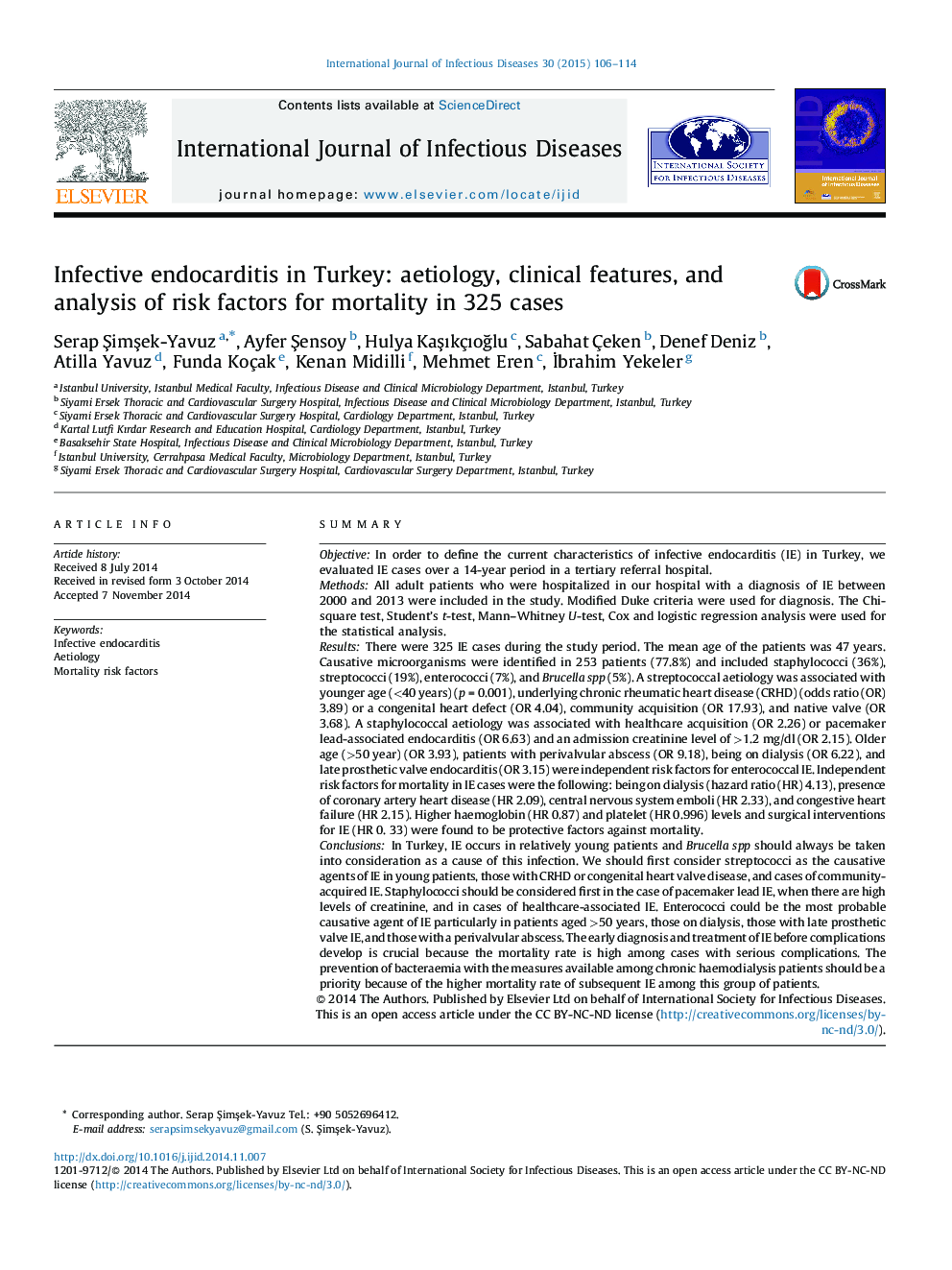| Article ID | Journal | Published Year | Pages | File Type |
|---|---|---|---|---|
| 3362288 | International Journal of Infectious Diseases | 2015 | 9 Pages |
•Brucella spp should be considered as a frequent cause of infective endocarditis (IE) in Turkey.•Community-acquired native valve IE in younger patients is generally caused by streptococci.•Healthcare-associated and pacemaker lead IE are generally caused by staphylococci.•Late prosthetic valve IE with perivalvular abscess in older patients is generally caused by enterococci.•The prevention, early detection, and effective treatment of bacteraemia are very important in chronic haemodialysis patients because of the unacceptably high mortality rate of subsequent IE among these patients.
SummaryObjectiveIn order to define the current characteristics of infective endocarditis (IE) in Turkey, we evaluated IE cases over a 14-year period in a tertiary referral hospital.MethodsAll adult patients who were hospitalized in our hospital with a diagnosis of IE between 2000 and 2013 were included in the study. Modified Duke criteria were used for diagnosis. The Chi-square test, Student's t-test, Mann–Whitney U-test, Cox and logistic regression analysis were used for the statistical analysis.ResultsThere were 325 IE cases during the study period. The mean age of the patients was 47 years. Causative microorganisms were identified in 253 patients (77.8%) and included staphylococci (36%), streptococci (19%), enterococci (7%), and Brucella spp (5%). A streptococcal aetiology was associated with younger age (<40 years) (p = 0.001), underlying chronic rheumatic heart disease (CRHD) (odds ratio (OR) 3.89) or a congenital heart defect (OR 4.04), community acquisition (OR 17.93), and native valve (OR 3.68). A staphylococcal aetiology was associated with healthcare acquisition (OR 2.26) or pacemaker lead-associated endocarditis (OR 6.63) and an admission creatinine level of >1.2 mg/dl (OR 2.15). Older age (>50 year) (OR 3.93), patients with perivalvular abscess (OR 9.18), being on dialysis (OR 6.22), and late prosthetic valve endocarditis (OR 3.15) were independent risk factors for enterococcal IE. Independent risk factors for mortality in IE cases were the following: being on dialysis (hazard ratio (HR) 4.13), presence of coronary artery heart disease (HR 2.09), central nervous system emboli (HR 2.33), and congestive heart failure (HR 2.15). Higher haemoglobin (HR 0.87) and platelet (HR 0.996) levels and surgical interventions for IE (HR 0. 33) were found to be protective factors against mortality.ConclusionsIn Turkey, IE occurs in relatively young patients and Brucella spp should always be taken into consideration as a cause of this infection. We should first consider streptococci as the causative agents of IE in young patients, those with CRHD or congenital heart valve disease, and cases of community-acquired IE. Staphylococci should be considered first in the case of pacemaker lead IE, when there are high levels of creatinine, and in cases of healthcare-associated IE. Enterococci could be the most probable causative agent of IE particularly in patients aged >50 years, those on dialysis, those with late prosthetic valve IE, and those with a perivalvular abscess. The early diagnosis and treatment of IE before complications develop is crucial because the mortality rate is high among cases with serious complications. The prevention of bacteraemia with the measures available among chronic haemodialysis patients should be a priority because of the higher mortality rate of subsequent IE among this group of patients.
